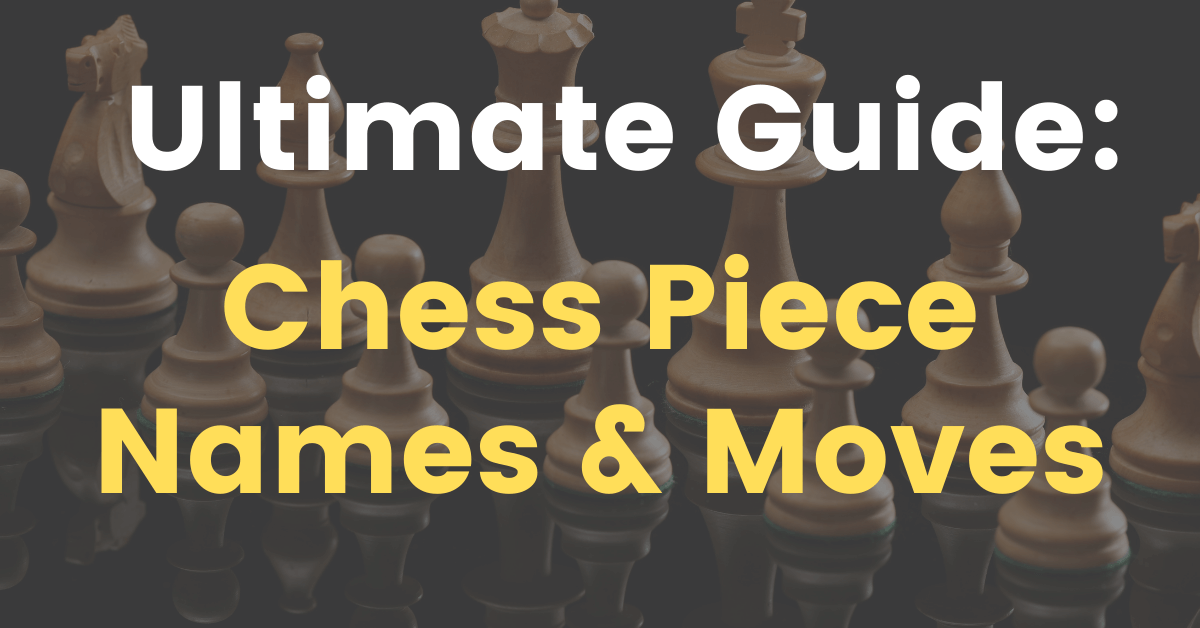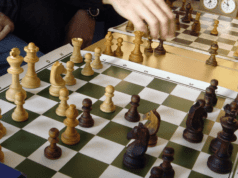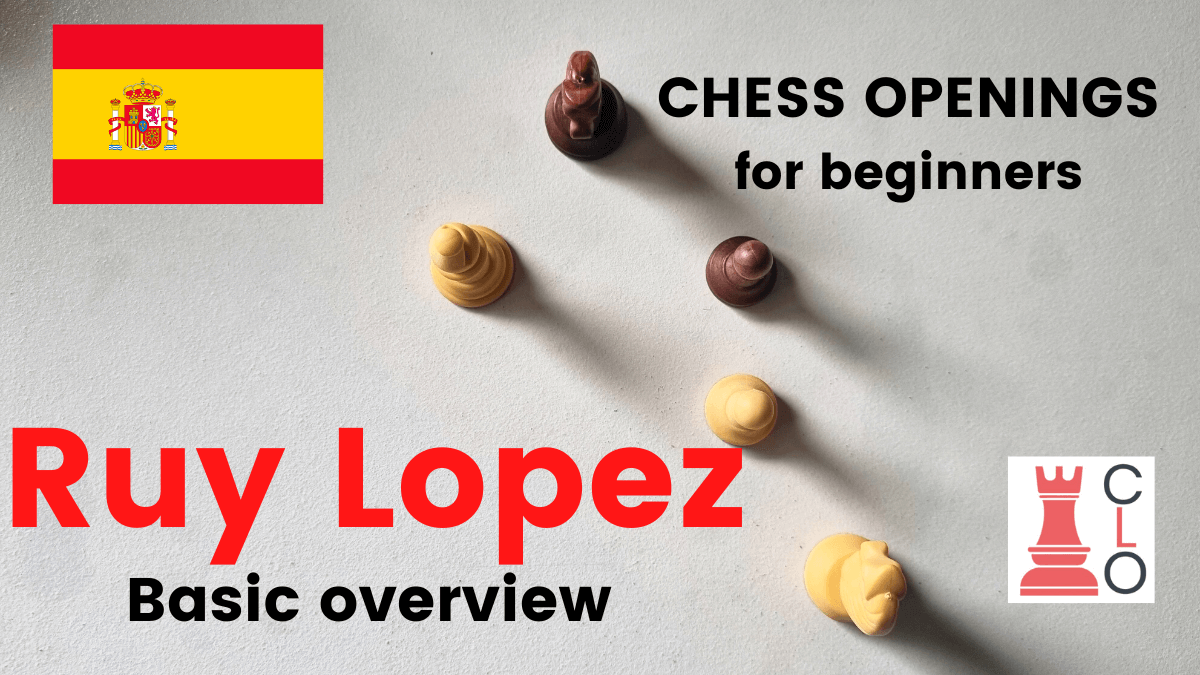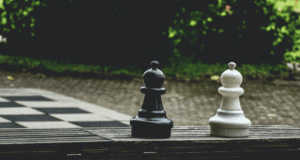Unleash Your Inner Chess Champion
Join our exclusive newsletter for opening guides, tips, and inspiration. Our community of 5,131+ chess enthusiasts is waiting for you.
Don't wait – enter your email below and join now!
What are the names of all the chess pieces?
The six different types of pieces in chess are called: king, queen, rook, bishop, knight, and pawn.
The chess pieces are what you move during a game of chess. The chess pieces’ names are a little confusing at first because there are so many chess pieces and they all have different movements that you need to memorise.
In particular, the queen moves in a wide range of ways and so queen moves are very difficult to predict in a chess game. However, this article will simply and clearly explain all of the pieces in the game of chess as well as all the different moves of the chess pieces.
After reading this ultimate guide to chess piece movements and names you will easily understand all of the chess pieces’ names and moves so that you can start your chess journey! Here are the names and pictures of all the chess pieces in the royal game of chess.
You may also like:
- Learn the Best Chess Opening for Beginners (You will be Suprised!)
- 100 Chess Endgames You Must Know to Win Chess!
- What the Best Videos and Websites to Learn Chess?
King Chess Piece
The king chess piece can be white or black depending on the player who controls it. Of course, there are also options in lichess.org and chess.com to change the look of the chess pieces. The picture below is what a king chess piece looks like normally.
You could also buy a real physical chess set and have more modern chess pieces or unique chess pieces that look fancier too. Some people also like to make their own modern chess boards and unique chess pieces too.
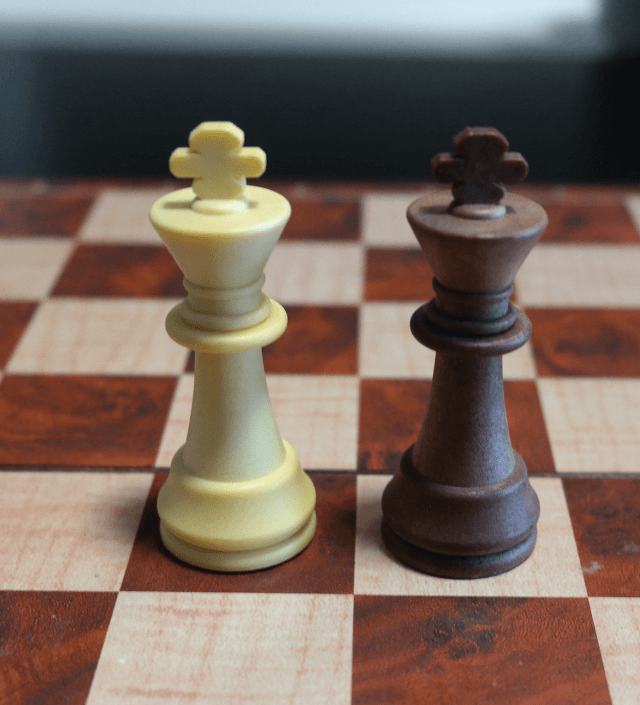
Queen Chess Piece
The queen piece can be white or black depending on whether the White or Black player controls it. The image below is what a queen chess piece looks like normally.
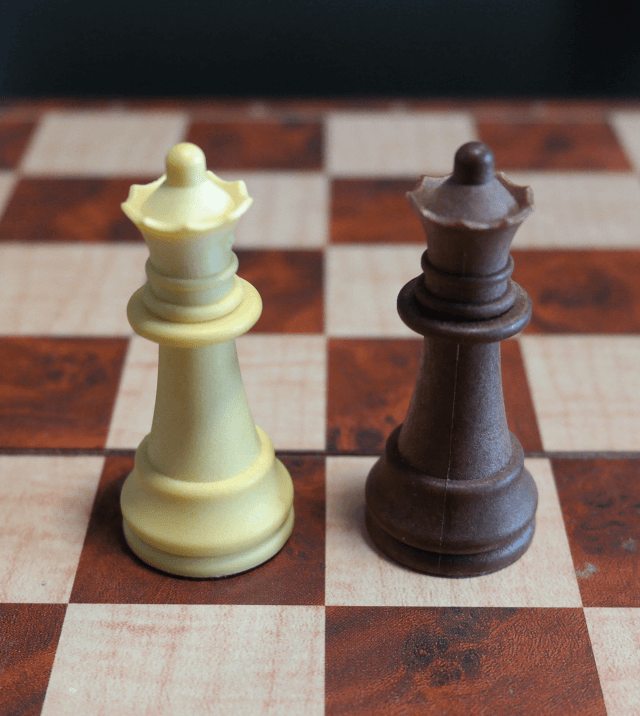
Rook Chess Piece
People often think the rook chess piece looks like a castle. Like the other chess pieces, the rook chess piece can be white or black depending on the player who controls it. The following image is what a rook chess piece looks like normally.
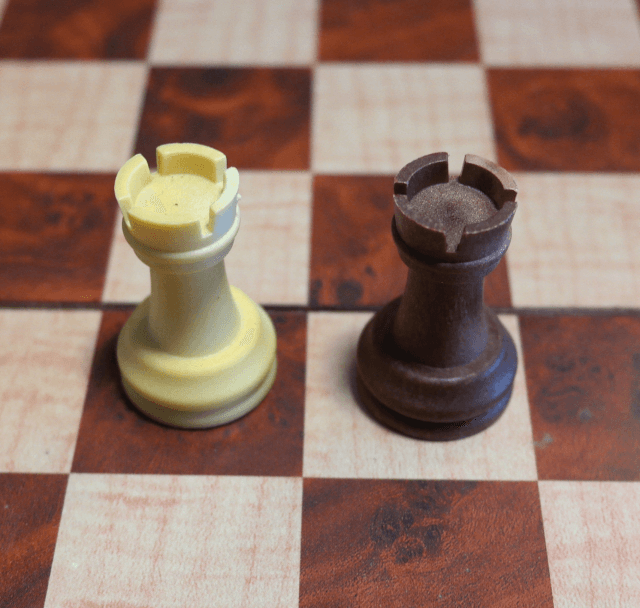
Bishop Chess Piece
The bishop chess piece can be white or black just like the other pieces on the chessboard. The picture below is what a bishop chess piece looks like.
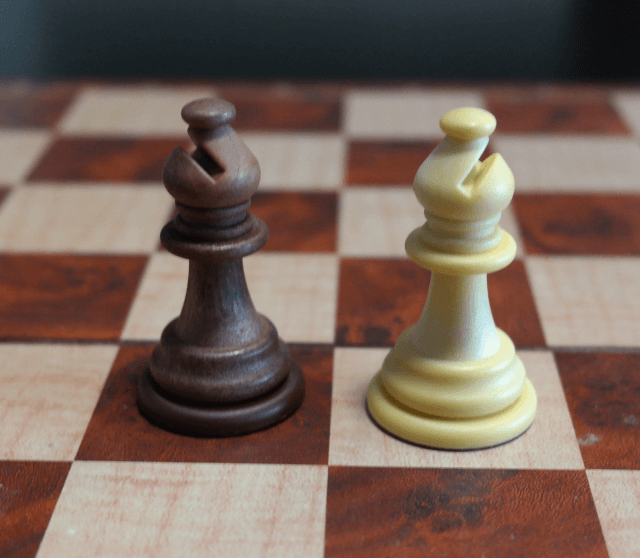
Knight Chess Piece
The knight chess piece also can be white or black. The image below is what a knight chess piece looks like.
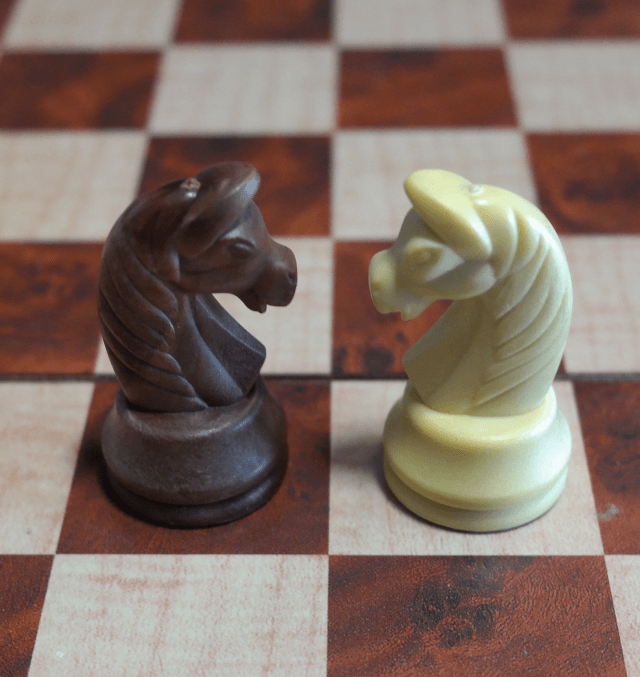
(Click here to read about the best beginner book for chess tactics by Yasser Seirawan)
Pawn Chess Piece
The pawn is the smallest chess piece and also has the least value.
The pawn chess piece can be white or black depending on the player who controls it. The image below is what a pawn chess piece looks like.
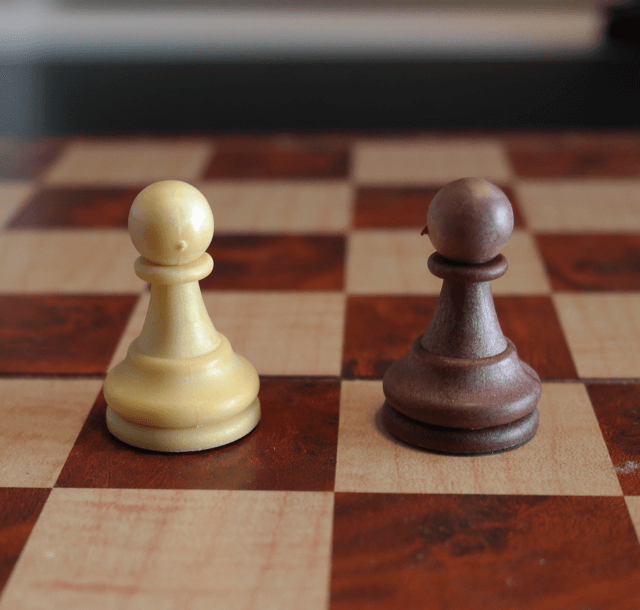
How many pieces are there on a chess board?
Each player starts with sixteen total pieces in chess.
That means that there are a total of 32 chess pieces on a chessboard at the start of a chess game (16 pieces for each player).
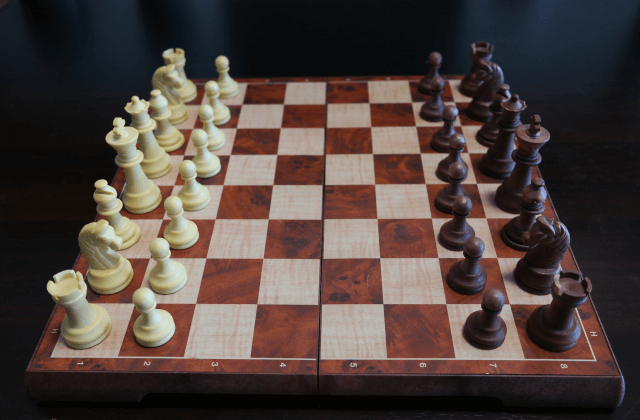
The 16 pieces that belong to each player are distinguished by colour.
The 16 white chess pieces are owned by one player (who is called ‘White’), and the 16 black chess pieces are owned by the other player (who is called ‘Black’).
In chess, the player who starts first is the player who owns the white chess pieces (i.e. White).
(Click here to learn what the best chess openings are to improve your chess game in an instant!)
In a standard game of chess, each player starts with the following 16 chess pieces:
1 king chess piece
1 queen chess piece
2 rook chess pieces
2 knight chess pieces
2 bishop chess pieces
8 pawn chess pieces
Chess Board Setup with Names:
Here is the chessboard starting position. The names of the chess pieces are attached.
As shown above, in the game of chess each player has 16 pieces and the chess pieces are white or black depending on which player owns them.
Thus, the correct chess board setup looks like this:
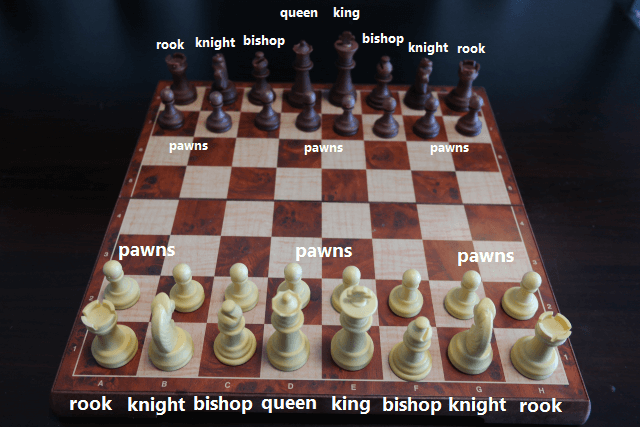
What are the starting positions of all the chess pieces on a chess board?
At the start of a chess game, the pieces are arranged according to the diagram above. For each side, there is one king, one queen, two rooks, two bishops, two knights, and eight pawns.
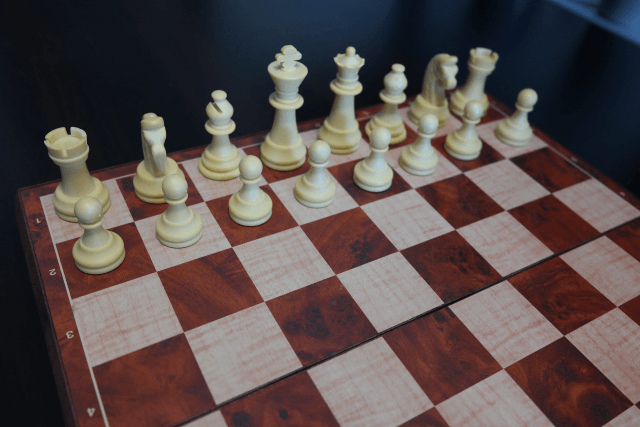
The pieces are placed on one square each on the chessboard as follows:
- The rooks are placed on the outside edges of the chessboard on the left and right.
- The knights are placed immediately inside of the rooks.
- The bishops are placed immediately inside of the knights.
- The queen is placed in the centre on the same colour square as the player – e.g. the white queen chess piece goes on a white square, and the black queen chess piece goes on a black square.
- The king is placed on the vacant central square next to the queen.
- The pawns are placed one square in front of all the pieces.
An easy way to remember how to set up chess pieces on a chessboard is: “queen on her own colour” and “white on right”.
The queen is always placed on the same colour as itself. Also, the square closest to the player’s right should be white.
How do you setup a queen and king on a chess board?
The white king chess piece is a black square and the white queen chess piece is on a white square. Also, the black king chess piece is on a white square and the black queen chess piece is on a black square.
Have a look at the chess set up for the king and queen in the diagram below.
(Click here to find out what the best videos are for learning about chess!)
You can remember this through these two sayings: “queen on her own colour” and “white on right”. “White on right” means that the square on the bottom right for each player is white.
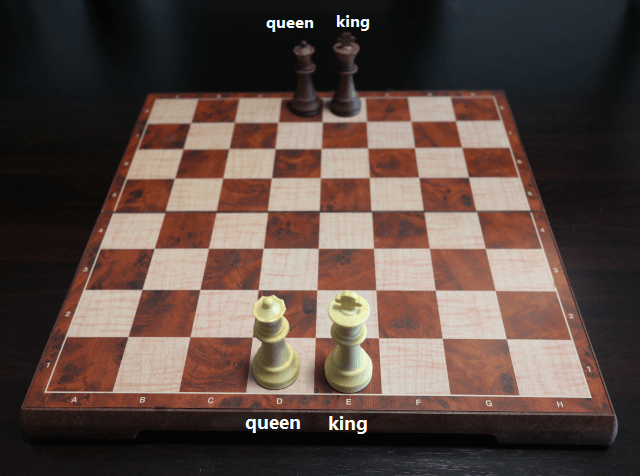
How do you remember where to put the queen and king on a chess board?
The black queen chess piece is on a black/dark square, and the white queen chess piece is on a white/light square.
An easy way to remember the correct chess game set up at the start of the chess game is to remember where the black queen chess piece and white queen chess piece are placed.
At the start of the chess game, the queens go on the same colour as themselves. This is the simplest strategy to help you remember where to put the queens on the chessboard!
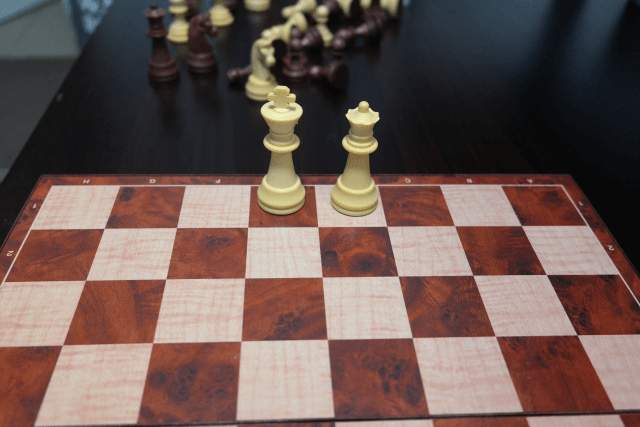
After placing the queens on the chessboard, there is only one space left in the middle of the chessboard. That is for the king. In other words, the kings go on the opposite colour as the pieces – the black king chess piece goes on a white square, and the white king piece goes on a black square.
I have also put a chessboard setup picture/image above to help you remember the starting positions for each of the chess pieces. It shows you the chessboard with the pieces in the correct place.
How do the chess pieces move?
There are a lot of chess piece movements in the game of chess. I will explain the chess piece moves one by one so that you see exactly what chess piece moves in what way.
I hope that it is very helpful for you when you want to learn the chess piece names and their moves. This will be particularly important for queen moves which are extremely varied and important to know in a chess game.
King Moves in Chess:
The king can move exactly one vacant square in any direction – left, right, forwards, backwards, or diagonally.
However, it cannot move to a square that is under attack by an opponent. Also, a player cannot move another piece if it means the king will be in check.
Here are the king chess piece moves.
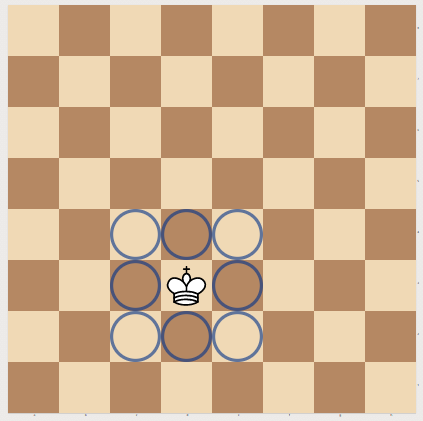
The king has a special move called ‘castling’ which I will explain below. The castling move is an extremely important move to know in the game of chess.
What is the Castling Move in the Game of Chess?
The castling move is a special king move that involves your king moving two spaces to its right or left and the rook on that side moving to the opposite side of the king.
Castling is considered to be one move.
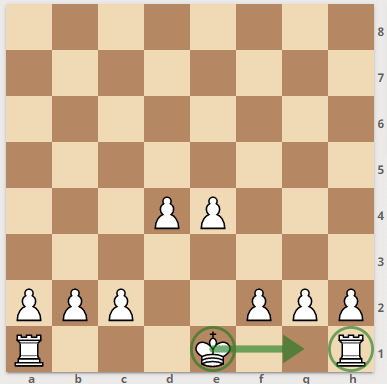
When you are castling your king, the king is transferred from its original square two squares towards the rook on its original square and then that rook is transferred to the square the king has just crossed.
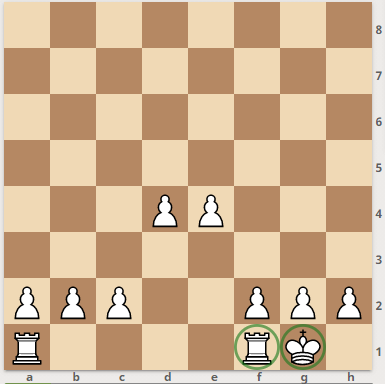
The King has just castled kingside.
He is nice and safe now!
Importantly, you can’t just do the castling move any time you want to. There are four key rules you need to follow when castling your king.
What are the Four Rules for Castling in Chess?
There are four castling rules in the game of chess.
- All the squares between the king and rook must be empty.
- The king and the rook must not have moved from their original starting squares.
- The squares that the king passes over, as well as the square where the king lands on after castling, must not be under attack.
- The king must not be in check.
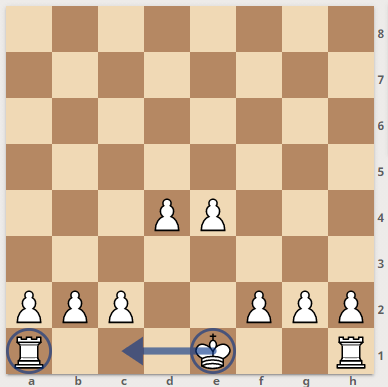
This means that there are some key times when you cannot do the castling move.
(Click here to learn how to play chess and win against any opponent!)
That is, you cannot do the special castling move when there are some pieces (e.g. a bishop or queen) that are attacking the squares which the king needs to pass through to castle.
Also, if the king or the rook have moved from their starting squares then the king cannot castle towards the rook that has moved. But if the king and the other rook haven’t moved, then the king can still castle towards the rook that hasn’t moved from its original starting square.
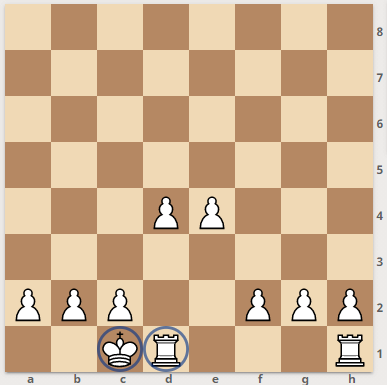
The King has just castled queenside.
The rook is ready to attack on the D-file!
How often can you do the castling move in the game of chess?
Your king can castle only once in a single chess game.
This is because one of the rules for the castling move is that the king must not have moved from its original square. After castling once, the king has moved and thus cannot castle again in the same chess game.
Queen Moves in Chess:
The queen can move any number of vacant squares in any direction – left, right, forwards, backwards, or diagonally in a straight line.
Here are the queen moves in chess.
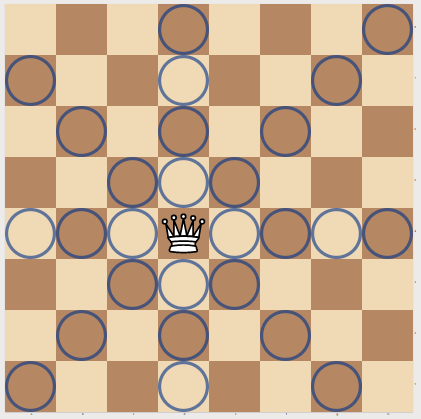
The movement of the queen in chess is the greatest and so the queen is considered to be the most valuable chess piece in the game of chess. That is why it is extremely important that you know how the queen moves in a chess game.
Rook Moves in Chess
A rook can move any number of vacant squares left, right, forwards, or backwards in a straight line. A rook cannot move diagonally at all.
Here are the rook moves in chess.
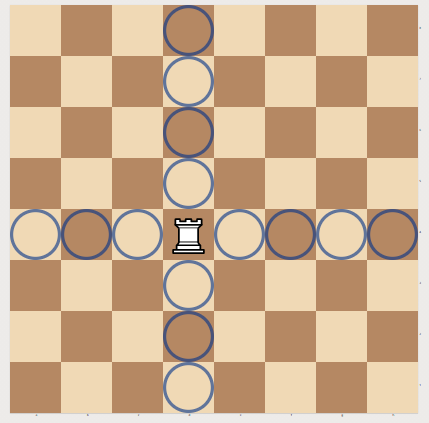
A rook can also take part in a special move called castling with the king (as explained above).
Bishop Moves in Chess:
A bishop can move any number of vacant squares diagonally in a straight line.
Here are the bishop moves in chess.
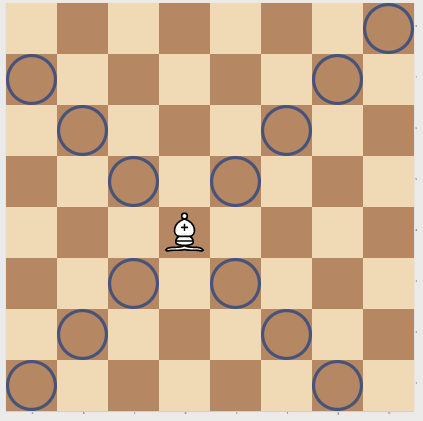
A bishop can only stay on the same colour throughout the entirety of the game. In other words, each player has a light-squared bishop (which can only move on light squares) and a dark-squared bishop (which can only move dark squares).
(Click here to read how to destroy your opponent in an open chess game with some razor-sharp bishops!)
Of course, this means that the two bishops with which each player starts move on opposite colour squares. Thus, the bishop movement in chess can be remembered as ‘diagonally forwards and backwards’.
In Chess, Can the Bishop Move Backwards?
Yes, the bishop can move backwards.
The bishop can move any number of vacant squares diagonally in a straight whether that be forwards or backwards.
Knight Moves in Chess:
The knight moves two squares in a straight line and then one square perpendicularly. This results in an “L” shape (a normal “L” or a back-to-front “L”).
In other words, the knight can move two squares forward, backwards, left or right and then one more square at a right angle.
Here are the knight chess piece moves.
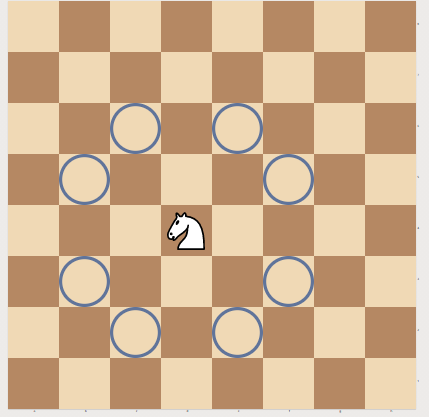
The knight moves in chess are the most confusing. That is because the movement of the knight in chess does not occur in a completely straight line.
The knight can jump over pieces in chess. Actually, it is the only piece in chess that can move over other chess pieces.
In other words, it doesn’t need to move through vacant squares and other pieces can’t block the knight. This makes the chess knight movement quite erratic and it can be easy to deceive your opponent when you have a knight near their king.
Pawn Moves in Chess:
Normally, a pawn can only move forward a single square.
However, the first time a pawn moves it can move either one square forward or two squares forward in a straight line. After it has been moved once, a pawn can only move forward one square in a straight line or attack a piece diagonally forward.
Here are the pawn moves in chess.
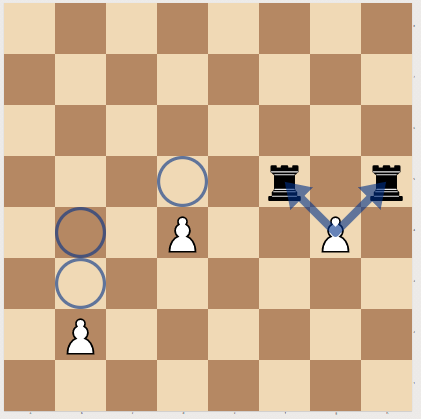
1. One or Two squares forward from the starting position
2. One square forward only after moving from the starting position
3. Capturing diagonally forward
A pawn cannot use the initial two-square forward move to jump over an occupied square or to capture an enemy piece. Any piece that is immediately in front of a pawn blocks the pawn’s advance forward.
Pawn Capture Rules in Chess
Pawns capture enemy chess pieces by moving one square diagonally forward to the left or right.
However, normally the pawn moves by moving forward one square (or two squares on its initial move) when not capturing.
The pawn is the only chess piece that can capture other pieces in a way that is different from how it normally moves.
Can a Pawn Attack on the First Move?
Pawns cannot attack anything on the first move of the game.
This is because there can not be anything diagonally in front of any pawns on the first move of a chess game.
However, a pawn can attack and capture an enemy piece from its original position if there is an enemy piece diagonally in front of the pawn.
Can a Pawn Move Diagonally Without Capturing?
No, a pawn can’t move diagonally without capturing.
Pawns capture only by moving diagonally. This is the only way pawns can capture, and this is the only way they can move diagonally.
At all other times, pawns can only move forward one square (or two squares forward on their initial move) when they are not capturing a piece.
What is the Special Pawn Move Called En Passant?
En Passant is a special pawn move that means “in passing” in French.
The special pawn move ‘En Passant’ can occur after an enemy’s pawn moves forward two squares from its initial position, and the square that is passed over is being attacked by your pawn.
Your pawn is able to capture the enemy pawn ‘in passing’ – as if the enemy pawn had only moved one square forward.
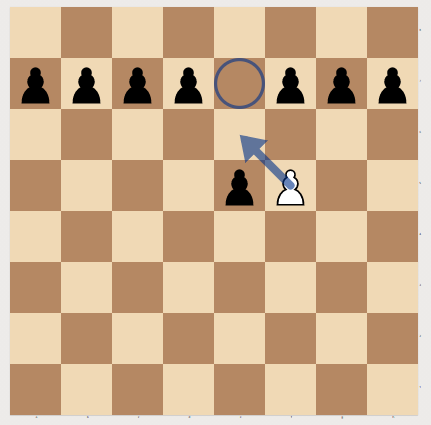
If the black pawn moves forward two squares from its starting position past the white pawn, then the white pawn can capture it.
However, the special pawn move ‘En Passant’ must be played on the move immediately following the double-forward pawn move. If you do not play En Passant immediately after the double-forward pawn move, then your option to play that particular En Passant move is lost for the remainder of the game.
(Click here to learn how to study any chess opening and improve your chess rating in a few hours!)
The special pawn move of En Passant rule was added in the 15th Century when the rule that gave pawns the initial double-forward move was added.
The En Passant move is important because it prevents a pawn from using the initial double-move to pass an adjacent enemy pawn without the risk of being captured.
Can Pawns Kill Backwards?
Pawns cannot kill or move sideways or backwards.
Pawns can only move forwards. When attacking another piece, the pawn must move one space diagonally forward. The pawn is different from other pieces because it is the only piece that does not kill in the same way as it moves. In other words, a pawn moves forwards but kills diagonally forward.
What are the Relative Values of the Chess Pieces?
The Queen is worth 9 points. The rook is worth 5 points. The knight and bishop are worth 3 points each, and the pawn is worth 1 point.
The relative point values of the chess pieces are set according to the benchmark of one pawn being 1 point of material value.
The values of the other chess pieces are then compared with the point value of a pawn by looking at the way each chess piece moves.
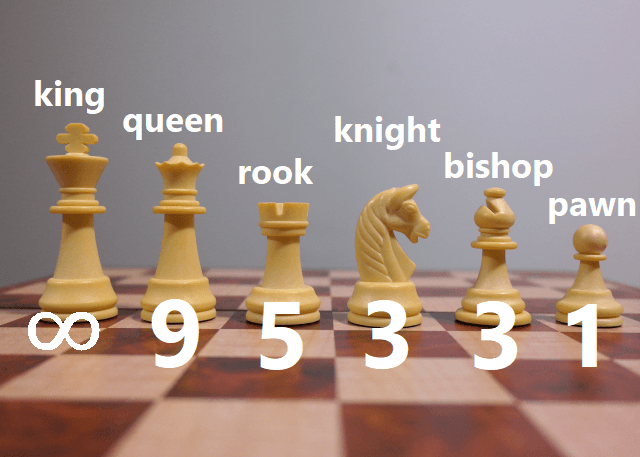
King – Unlimited
Queen – 9 points
Rook – 5 points
Knight/Bishop – 3 points
Pawn – 1 point
First, you need to know the chess piece names, and then you need to know how the chess pieces move. The final thing you need to know is the relative values of the chess pieces.
In order to play the game of chess well without blundering, you need to know the chess piece values.
Some chess pieces are more valuable than others. You wouldn’t give up your queen for one of your enemy’s pawns because the queen is worth 9 points, and your enemy’s pawns are only worth 1 point.
The queen moves in an extremely mobile way which means that the queen can control more of the board than the other pieces. Therefore, the queen is worth 9 points of material value.
However, the pawn can move forward only one or two spaces and attacks only two squares diagonally forward. So pawns don’t control much of the chessboard compared to the other pieces. Therefore, pawns are only worth 1 point of material value.
So before capturing an enemy chess piece with one of your pieces, you need to make sure the capture is worth your time by comparing the point values of the chess pieces.
The point values of each of the chess pieces are explained below.
King Chess Piece Point Value
The point value of the king is infinite.
This is because when your king is lost (i.e. you are checkmated) then you have lost the game.
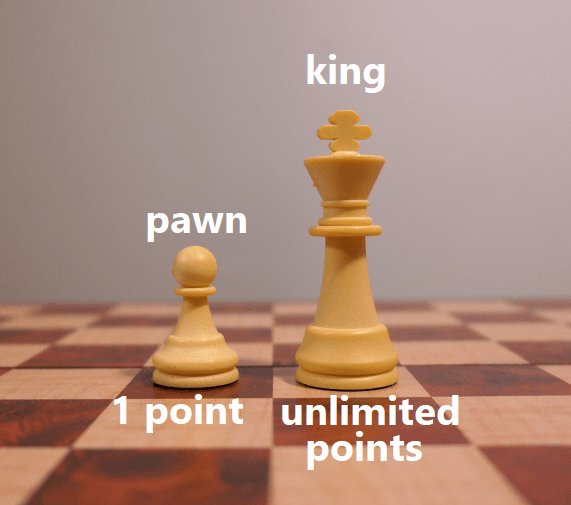
One of the most important aspects of a chess game is the safety of your king.
You must always make sure that your king is safe during a chess game.
One of the ways of making sure your king is safe is developing your pieces and castling your king in the opening phrases of the chess game. I have explained the special castling move for the king above.
Queen Chess Piece Point Value
The point value of the queen is 9 points.
This is because the queen can move in a wide variety of ways compared to the other pieces.
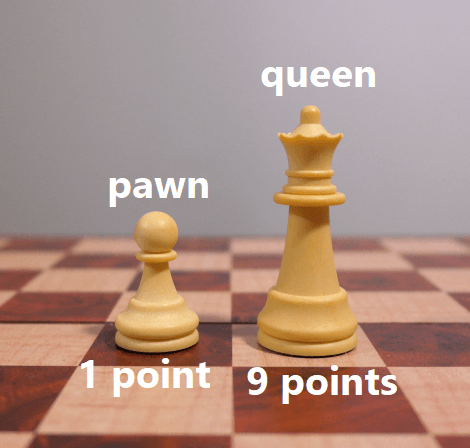
The queen can move in all directions (left, right, forwards, backwards, and diagonally) any number of vacant squares. Therefore, the queen can control more of the chessboard than other pieces and is therefore an extremely valuable attacking piece.
Rook Chess Piece Point Value
The point value of a rook chess piece is 5 points.
This is because the rook can move horizontally and vertically any number of vacant squares.
When two rooks team up on the same rank (i.e. row) or file they can much more powerful.
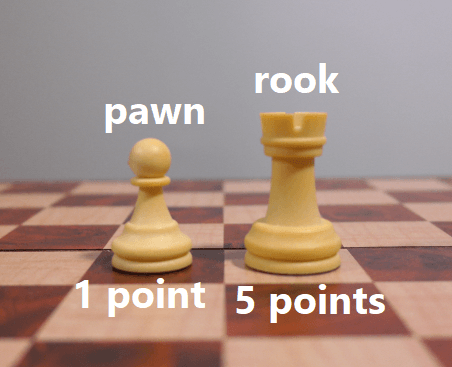
Two rooks together are 10 points (2 x 5 points) and so in certain situations, two rooks can be more valuable than one queen (whose point value is 9 points).
Bishop Chess Piece Point Value
The point value of a bishop chess piece is 3 points.
This is because the bishop can only move diagonally and so is less valuable than a queen or a rook.
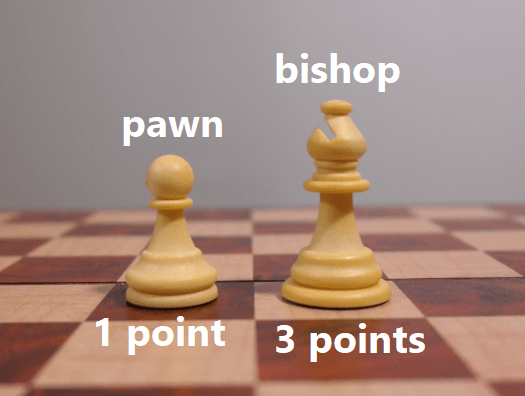
There are certain situations where two bishops are worth more than their combined relative point value though.
This is when the chessboard is more open and lots of pieces have been captured.
Having an open chessboard (i.e. there are no pawns blocking the bishops’ scope) means that the bishops have more mobility and thus control more of the open board.
Knight Chess Piece Point Value
The point value of a knight chess piece is 3 points.
This is because the knight can only move in a very limited way compared to the other chess pieces.
At most a knight can only control 8 squares altogether. In contrast, a queen can control at most 27 squares. So you can see why the queen is more valuable and thus worth more points than a knight then, right?
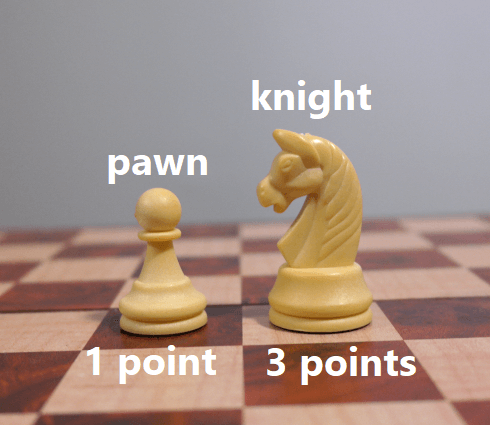
However, there are certain situations where a knight (or two) can be very valuable.
One situation is early in the game where a knight can help control the centre of the board really well.
Another situation is in closed positions (i.e. where pawns are locked together and can’t move or attack each other).
In closed situations, other pieces such as bishops and queens have limited mobility because the enemy pawns block their scope. However, knights can easily jump over pawns into key squares to wreak havoc on an enemy’s position.
Pawn Chess Piece Point Value
The point value of a pawn chess piece is 1 point.
This is because the pawn can only move forward one square or two squares at most.
They control the least of the board compared to the other chess pieces.
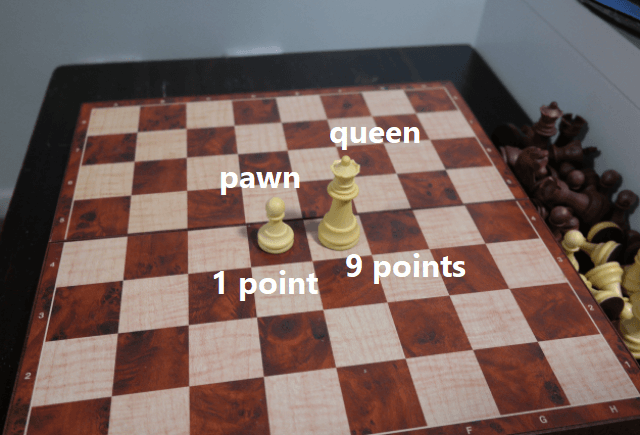
However, there are certain situations when a pawn can be very valuable.
One situation is when a pawn is one square away from promotion.
Promotion in the game of chess is when a pawn reaches the other side of the board and thus can promote to a queen, a rook, a bishop, or a knight.
If your pawn is one square away from promotion and there are no enemy pieces that can stop it, then that pawn could worth as much as a queen because in one more turn it will become a queen.
Protected passed pawns are another situation where pawns can be extremely valuable.
A protected passed pawn is a pawn that is protected by another pawn and where it cannot be prevented by enemy pawns in advancing to the end of the board to promotion.
What are the Most Important Pieces in Chess?
The most important pieces in the game of chess are the king and the queen.
If you lose your king (i.e. you are checkmated), you lose the game. Therefore, the king is the most important piece in the game of chess and has an unlimited point value.
The queen can control at most 27 squares in a game of chess, and so has the greatest mobility compared with other chess pieces. Therefore, the queen is the second most important chess piece after the king and is worth nine points of material value.
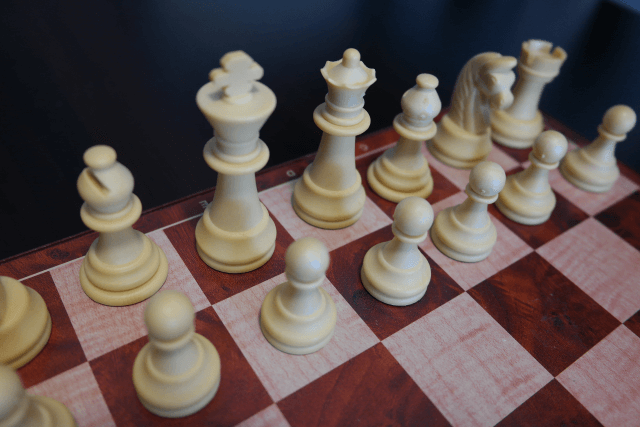
the King and the Queen
As in the chess drama, the Queen’s Gambit, if you lose your queen without any compensation most people resign the game.
However, if you are just starting out in chess it’s important to continue playing the game even if you have lost your queen because your opponent might make one or more blunders giving you a chance to still win the game.
What is the Weakest Chess Piece?
The weakest chess piece is the pawn because it is worth only one point of material value.
A pawn can only move forward one or two squares and can only attack diagonally forward making it very weak compared to other chess pieces. However, there are some situations where a pawn can be very valuable.
For example, when it is one square away from promotion or when it is a protected passed pawn.
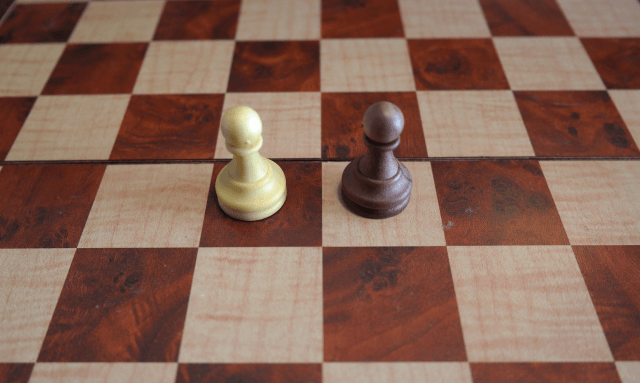
The poor pawn
Is the Bishop or the Knight More Valuable?
Bishops and Knights are worth the same amount of points in material value – 3 points each.
However, a bishop is considered to be slightly more valuable than a knight in a game of chess.
This is because bishops can move across more of the board faster than a knight. Also, you can force mate with 2 bishops but you can’t force mate with 2 knights vs an opponent’s sole king.
However, it depends on the chess position.
In closed positions where the centre is blocked by pawns, knights can be better than bishops because they can jump over the pawns which block the centre.
But bishops are more valuable than knights in open positions, where the centre isn’t blocked by pawns and there are lots of open diagonals to use.
Is a Rook worth a Knight and a Bishop?
According to Alburt and Krogius (2003), in an endgame, a rook and one pawn are equal to or slightly weaker than a bishop and a knight, or equal to two knights. Whereas, a rook and two pawns are equal to two bishops.
However, in the opening and the middle game, a rook and two pawns are equal or slightly weaker than a bishop and a knight, equal to two knights, and weaker than two bishops.
This shows that the relative value of chess pieces changes depending on whether it is the opening, the middlegame, or the endgame.
The relative value of chess pieces also changes depending on the chess position as well – e.g. whether the pieces are in the centre or in the corner, and whether the chess position is open or closed.
Are Two Rooks Better than a Queen?
In the middle game, two rooks are equal to a queen.
But in the endgame, the two rooks are a little stronger than a single queen. With no other pieces on the chessboard in the endgame, two rooks are equal to a queen and a pawn.
Typically, a queen can move across more of the chessboard than other pieces so it is worth more (9 points). Two rooks together can control a wide range of the chessboard and together they are worth 10 points (1 rook = 5 points).
But as the chess game progresses towards the endgame, the relative value of chess pieces change in value.
The value of pawns, rooks, and to a lesser extent bishops may increase as the game heads to the endgame.
This is because the board generally tends to open up and more lines, files and diagonals are available for these pieces to utilise.
The knight tends to lose some power, and the strength of the queen may be slightly lessened too. This is because knights need more time to move from one side of the chessboard to the other in an endgame compared to, for example, rooks and bishops.
What next for Chess and ChessLoversOnly?
Keep coming back to Chess Lovers Only for more chess-related news and chess opening studies! We can tell you how to destroy your opponent in the Open Game as well as how to win using the Italian Game.
What should we write about next?
Let us know in the comment box below!
Or Contact Me here.
Cheers,
A.J. McMahon
.
.
.
Let’s Connect!
– Youtube: ChessLoversOnly
– Instagram: Chess.Lovers.Only
– Pinterest: ChessLoversOnly
– Facebook: ChessLoversOnly
– Twitter: @ChessLoversOnly


